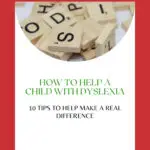We have a guest post today from Kate Griggs, the Made by Dyslexia founder, and following the release of her new book This is Dyslexia. We are chatting about how to help a child with dyslexia, whether you are a parent or an educator.

This Is Dyslexia is the second book written by Made By Dyslexia Founder and CEO, Kate Griggs.

This is Dyslexia by Kate Griggs
The definitive guide to the untapped power of dyslexic thinking was released on World Dyslexia Day (7th October 2021) and published by Penguin Random House.
It redefines and reshapes what it means to be dyslexic and explores how dyslexia has shaped our past and how harnessing its powers is vital to our future.
This Is Dyslexia is available to buy now on Amazon, or you can find alternative stockists on the Penguin website.
Why not take a look today and see how you can support and help those with Dyslexia and tap into their original and innovative thinking.
Remember, one of the most important things with any of this is understanding that your child thinks differently, but that doesn’t mean that their contributions are any less valid to the family, or society.
In fact, it can mean that they have a unique perspective that needs to be heard, and taken into consideration even more.
Open your mind, as well as your ears. Practise active listening even!
We asked Kate and Penguin if we were able to share some of the book with our readers to both help them, and also so they could see the valuable information that it provides to readers.
So we are sharing 10 ways that you can make a difference to children with dyslexia, depending on whether you are a parent, or an educator. For more information, do check out the book too.
How to help a child with dyslexia if you’re the parent:
- Know that your child is brilliant, they just think differently. Remind them that this thinking is super valuable in the real world.
- Help them to find their strengths and passions. Every dyslexic child has Strengths, they may not be super obvious, but they are there.
- Praise and nurture their strengths at every opportunity and make sure their teachers do this too. This is vital for self-esteem.
- You know your child better than anyone, so trust your gut when asking for help. Most teachers aren’t trained, and many schools don’t like to label. Be persistent. Don’t give up.
- Remember their struggles are real, and the sooner they get support, the sooner they can learn, catch up and keep up.

What to do to help if you are an educator:
- Remind yourself that the dyslexia ‘label’ is a good thing, for teachers, parents and kids. It helps everyone understand their strengths and challenges and to give the right intervention.
- Understand that methods that work for dyslexic kids are actually good for all kids.
- Never ask a dyslexic child to try harder. They have to work much harder than other kids to learn. Instead, think about how you can change your teaching to make things easier for them.
- If a child is struggling with spelling, or remembering math facts, or there is a difference in what they can explain verbally and get on paper – think dyslexia.
- Remember, these are brilliant children who don’t fit into the traditional education mould. Let them think outside the box and be creative and celebrate their different thinking.

For a little background to the organisation that Kate founded; Made By Dyslexia is a global charity led by successful dyslexics. Launched in 2017, their purpose is to help the world understand, value and support dyslexia.
Their mission is to train every teacher and workplace to spot, support and empower dyslexic minds. This mission is aligned with the UN Sustainable Development Goals, which they aim to achieve by 2030.
We hope that you find this article helpful – for more articles focused on special needs on KiddyCharts, do check these out:
Other articles on KiddyCharts relevant to Special Needs
Here are some articles and resources that are helpful to those caring for children with special needs.
How to explain autism to children #31DaysOfLearning
How to explain what autism is to children.
OCD and autism: Understanding the difference in children
Understanding the differences between OCD and Autism.
10 things for parents of special needs children to do when they are stuck indoors
Help to come up with activities if you are stuck indoors with your child.
Parenting a Special Needs Child: 5 top tips
Some top tips from a parent of a child with special needs on how to cope.
Here are some more ideas from outside KiddyCharts too:
Other resources from the internet focused on support in Special Needs
Here are some more ideas for supporting children with Special Needs.
12 Activities to Promote Eye Contact
Encouraging eye contact is a great way to assist with promoting improvements in social skills.
5 Clean Science Experiments for Autistic Children
Sometimes children with autism don't like getting too messy - so here is some science fun for them!
48 Quick Sensory Bags to Make for Your Kids
Sensory play is excellent for supporting children with special needs, so here are loads of different ideas for you.
We hope that you find these ideas useful – do sign up to our weekly newsletter if you do:
Cheers for popping in,
Helen








